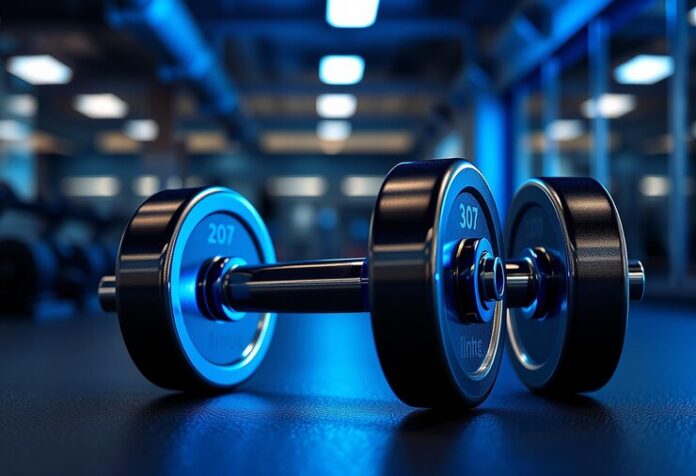Dumbbells are a staple in strength training routines. Whether you’re a beginner or a seasoned athlete, dumbbells offer versatility, convenience, and efficiency. These compact weights allow for the isolation of specific muscles and provide a dynamic range of exercises that target almost every muscle group. If you’re looking to boost your strength, balance, and muscle endurance, incorporating dumbbells into your workout is one of the best ways to achieve that.
The Benefits of Using Dumbbells
Versatility in Exercises
Dumbbells allow for greater freedom of movement than machines or barbells. Whether you’re performing curls, squats, or presses, dumbbells can target multiple muscle groups. This unilateral training option also helps to balance strength between both sides of the body, preventing muscle imbalances that often occur with barbells.
Improved Range of Motion
Since dumbbells are independent weights, they allow for a greater range of motion than most traditional weight-lifting equipment. This freedom enables you to work muscles more deeply, fostering better muscle growth and joint flexibility.
Enhanced Core Stability
Using dumbbells requires more than just lifting. Engaging your core for stabilization throughout exercises like overhead presses or lunges helps improve your overall balance and stability, strengthening your midsection and reducing the risk of injury.
Convenience and Accessibility
Unlike other bulky gym equipment, dumbbells are compact and portable. They can be stored easily at home, making them an ideal solution for at-home workouts. With adjustable dumbbells, you can even increase or decrease weight without needing a vast collection of equipment.
Types of Dumbbells
Fixed Dumbbells
These are the standard dumbbells you see in most gyms. The weight is set and cannot be adjusted. They’re available in a wide range of weights, from light to very heavy, making them ideal for targeting both small and large muscle groups.
Adjustable Dumbbells
Adjustable dumbbells allow for quick and easy changes in weight. These are ideal for people with limited space as they take up less room than a full set of fixed dumbbells. With just a few plates or a single mechanism, you can switch between weights efficiently during your workout.
Studio Dumbbells
These are usually lighter weights covered in rubber or vinyl and are typically used in aerobic or light resistance training. They’re perfect for beginners or those focusing on high-repetition workouts for endurance and toning.
Hex Dumbbells
These are similar to fixed dumbbells, but with hexagonal-shaped ends to prevent rolling. They’re commonly used for cross-training and functional fitness exercises.
How to Choose the Right Dumbbells for Your Workout
Choosing the right dumbbells depends on your fitness goals and experience.
- Beginners: If you’re new to strength training, start with lighter weights to master the proper form. Look for weights that challenge you but still allow you to maintain control.
- Intermediate to Advanced: As your strength improves, move to heavier weights. A good rule of thumb is to increase the weight when you can do more than 12-15 reps easily.
- Home Gym Enthusiasts: If space is a concern, consider investing in adjustable dumbbells. This ensures you can progress in your training without the need for multiple sets.
Effective Dumbbell Exercises for Strength Training
Here are some of the most effective dumbbell exercises that target different muscle groups:

Dumbbell Bench Press
This exercise primarily targets your chest muscles (pectorals), but it also engages your triceps and shoulders. Lie flat on a bench with a dumbbell in each hand and push them upward in a controlled motion.
Dumbbell Squats
Dumbbell squats engage your quads, glutes, hamstrings, and core. Hold a dumbbell in each hand at your sides or one heavy dumbbell close to your chest and lower your body into a squat position, keeping your back straight.
Dumbbell Rows
Rows are perfect for building a strong upper back. Place one knee on a bench for support, hold a dumbbell in one hand, and row it toward your rib cage, engaging your lats and traps.
Dumbbell Lunges
Dumbbell lunges work on your legs and glutes while challenging your balance. Hold a dumbbell in each hand and step forward into a lunge, ensuring your front knee stays behind your toes.
Dumbbell Shoulder Press
This exercise strengthens your shoulders, traps, and triceps. Press a dumbbell in each hand above your head and lower it down to shoulder height with control.
Dumbbell Bicep Curls
The classic bicep curl targets the muscles in your upper arm. Hold a dumbbell in each hand with your palms facing forward and curl the weights toward your shoulders.
How to Incorporate Dumbbells into Your Workout Routine
To maximize the benefits of this, integrate them into your weekly workout routine:
- Full-Body Workouts: Dumbbells are perfect for full-body circuits. Include exercises like squats, lunges, and rows to work multiple muscle groups in one session.
- Push-Pull Splits: Use dumbbells for push exercises (chest press, shoulder press) on one day and pull exercises (rows, curls) on another. This helps balance your muscle development and prevents overtraining.
- High Repetition Training: For endurance and toning, opt for lighter weights and aim for 15-20 repetitions per set.
- Strength Building: Use heavier weights for lower reps (around 6-10), focusing on compound movements like squats and presses for maximum muscle recruitment.
Safety Tips for Dumbbell Training
- Warm-Up Properly: Always start your workout with a dynamic warm-up to increase blood flow and loosen up your muscles.
- Maintain Proper Form: Ensure you’re using the correct technique for each exercise. Poor form can lead to injury, particularly when lifting heavier weights.
- Progress Gradually: Don’t rush to increase your weight. Gradual progression helps build strength safely and effectively.
Conclusion
Incorporating dumbbells into your fitness routine is one of the most efficient ways to build muscle, improve balance, and increase core stability. With their versatility and ease of use, dumbbells provide a dynamic range of exercises for all fitness levels. Whether you’re training for strength or endurance, dumbbells can enhance your workouts and help you reach your fitness goals.




